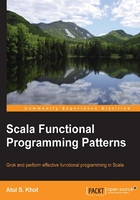
Tail recursion to the rescue
There is a technique, an optimization really, that helps us get out of the logjam. However, we need to tweak the code a bit for this. We will make the recursive call as the last and only call. This means that there is no intermediate context to remember. This last and only call is called the tail call. Code in this tail call form is amenable to TCO. Scala generates code that, behind the scenes, uses a loop—the generated code does not use any stack frames:
import scala.annotation.tailrec def count(list: List[Int]): Int = { @tailrec // 1 def countIt(l: List[Int], acc: Int): Int = l match { case Nil => acc // 2 case head :: tail => countIt(tail, acc+1) // 3 } countIt(list, 0) }
The changes are like this:
We have a nested workhorse method that is doing all the hard work. The count method calls the countIt nested recursive method, with the list it got in the argument, and an accumulator. The earlier intermediate context is now expressed as an accumulator expression with the help of the following steps:
- The
@tailrecannotation makes sure that we are doing the right things so that we benefit from the TCO. Without@tailrec, Scala may apply the optimization or it may not. The@tailrecannotation is a helping hand to ensure that the function call is optimized. Try the same annotation on our first version. You will get a compilation error. - Play time: Change the second case in the previous code as shown:
case head :: tail => { val cnt: Int = countIt(tail, acc + 1) println(cnt) cnt }
- You will get a compilation error after changing the second case:
Error: could not optimize @tailrec annotated method countIt: it contains a recursive call not in tail position - When the execution lands in this clause, we are at the end of the list. We are not going to find any more elements, so the base case just returns the accumulator.
- There is no intermediate context now—just a tail call. This is the only and last recursive call. We found one more element. We increment the accumulator to record the fact and pass it on.
Compared to the earlier version, why does this version work? If the compiler can use tail call optimization, then it does not need to stack up the context. So, no stack frames are needed as the resulting executable code uses loops behind the scenes.